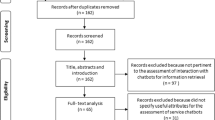Abstract
This report compared production of infinitival object complements during conversational language sampling to production on an elicitation task. Subjects included 25 children between the ages of 3;7 and 5;4. The children produced more two-noun infinitives and produced infinitives with more main verbs on the elicitation task. In the conversational samples, the children produced infinitives almost exclusively with early-appearing main verbs. These findings suggest that conversational language sampling may underestimate children's grammatical knowledge.
Similar content being viewed by others
REFERENCES
Bacchini, S., Kuiken, F., & Schoonen, R. (1995). Generalizability of spontaneous speech data: The effect of occasion and place on the speech data of children. First Language, 15, 131–150.
Bloom, L. (1970). Language development: Form and function in emerging grammars. Cambridge, MA: MIT Press.
Bloom, L., Tackeff, J., & Lahey, M. (1984). Learning to in complement constructions. Journal of Child Language, 11, 391–406.
Bowerman, M. (1973). Early syntactic development: A cross-linguistic study with special reference to finish. Cambridge, UK: Cambridge University Press.
Brown, R. (1973). A first language. Cambridge, MA: Harvard University Press.
Eisenberg, S. L. (1989). The Development of Infinitives by three, four, and five year-old children. Unpublished doctoral dissertation, City University of New York.
Eisenberg, S. L., & Cairns, H. S. (1994). The development of infinitives from three to five. Journal of Child Language, 21, 713–734.
Evans, J. L., & Craig, H. K. (1992). Language sample collection and analysis: Interview compared to free play contexts. Journal of Speech and Hearing Research, 35, 343–353.
Heiman, G. W. (1992). Basic statistics for the behavioral sciences, Boston, MA: Houghton-Mifflin.
Lahey, M. (1988). Language disorders and language development. New York: Macmillan.
Lee, J. L. (1974). Developmental sentence analysis. Evanston, IL: Northwestern University Press.
Limber, J. (1973). The genesis of complex sentences. In T. E. Moore (Ed.), Cognitive development and the acquisition of language. New York: Academic Press.
MacWhinney, B. (1995). The CHILDES Project: Tools for analyzing talk, (2nd ed.). Hillsdale, NJ: Erlbaum.
MacWhinney, B., & Snow, C. (1985). The child language data exchange system. Journal of Child Language, 12, 271–296.
Menyuk, P. (1969). Sentences children use. Cambridge, MA: MIT Press.
Miller, J. F. (1981). Assessing language production in children. Baltimore, MD: University Park Press.
Stromswald, K. (in press). Contribution to appear in D. McDaniel, C. McKee, & H. Cairns (Eds.), Methods for Assessing Children's Syntax. Cambridge, MA: MIT Press.
Author information
Authors and Affiliations
Rights and permissions
About this article
Cite this article
Eisenberg, S. Investigating Children's Language: A Comparison of Conversational Sampling and Elicited Production. J Psycholinguist Res 26, 519–538 (1997). https://doi.org/10.1023/A:1025075714023
Issue Date:
DOI: https://doi.org/10.1023/A:1025075714023




